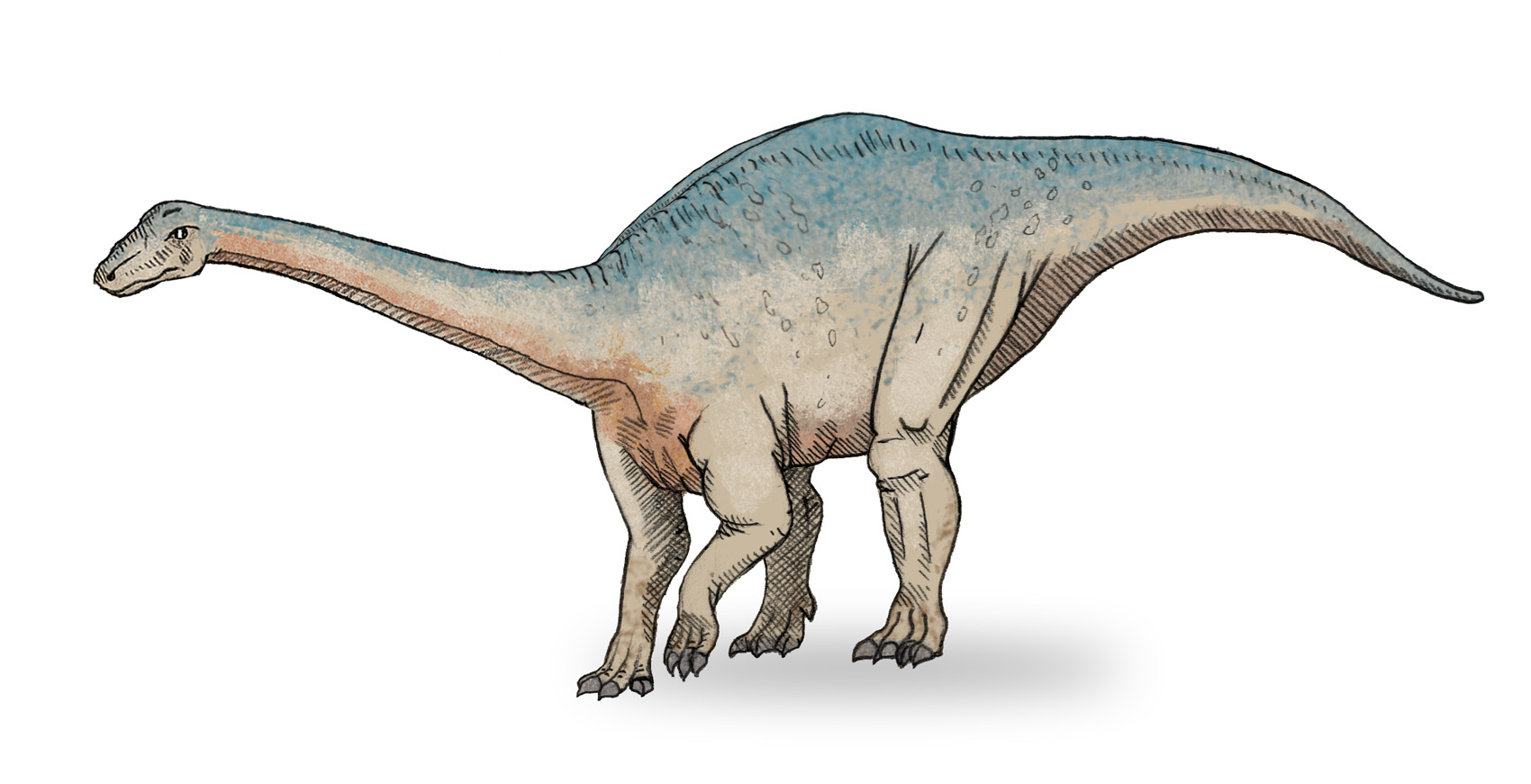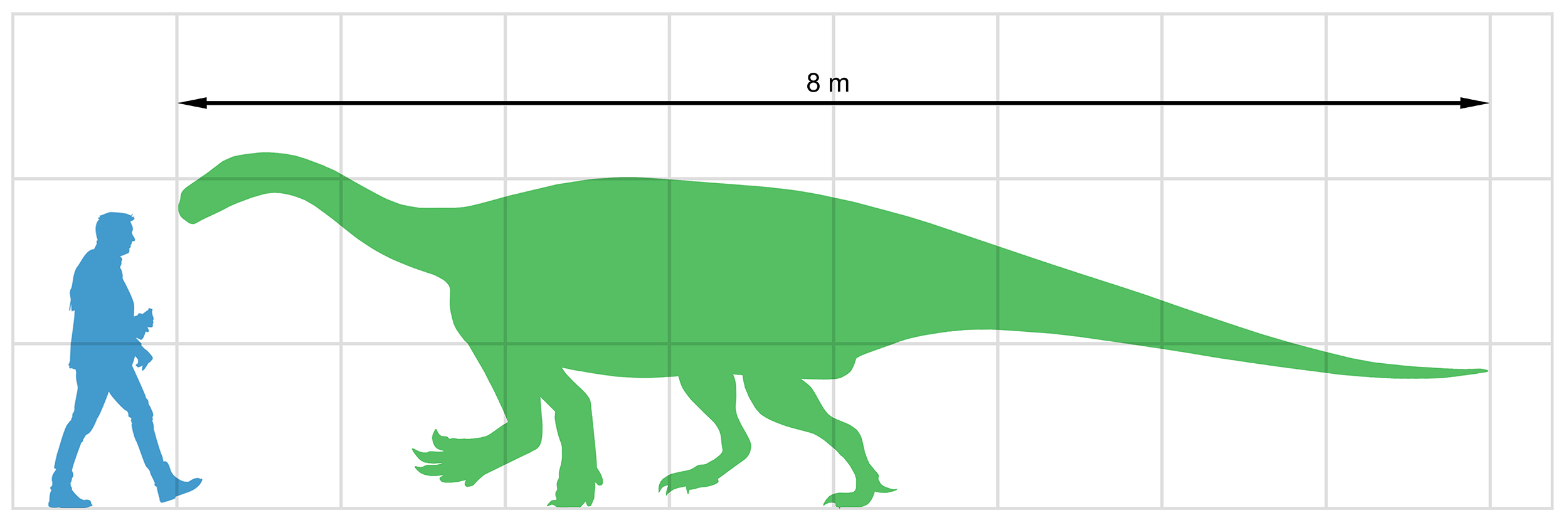|
Isanosaurus
''Isanosaurus'' means "North-eastern thailand lizard" was a sauropod dinosaur from Thailand. It was originally dated to approximately 210 million years ago during the Late Triassic (late Norian to Rhaetian stages), which would make it one of the oldest known sauropods. Its age was later considered uncertain, and may be as young as Late Jurassic. The only species is ''Isanosaurus attavipachi''. Though important for the understanding of sauropod origin and early evolution, ''Isanosaurus'' is poorly known. Exact relationships to other early sauropods remain unresolved. Description The only specimen includes a neck vertebra, a back vertebra and part of a second, six tail vertebra, two chevrons, fragmentary ribs, the right sternal plate, the right shoulder blade, and the left thigh bone (femur). This individual may have measured when alive; the thigh bone measures 76 centimetres in length. However, the vertebral neural arches have been found separated from the vertebral ce ... [...More Info...] [...Related Items...] OR: [Wikipedia] [Google] [Baidu] |
Antetonitrus
''Antetonitrus'' is a genus of sauropod dinosaur found in the Early Jurassic Elliot Formation of South Africa. The only species is ''Antetonitrus ingenipes''. As one of the oldest known sauropods, it is crucial for the understanding of the origin and early evolution of this group. It was a quadrupedal herbivore, like all of its later relatives, but shows primitive adaptations to use the forelimbs for grasping, instead of purely for weight support. Discovery and naming Adam Yates, an Australian expert on early sauropodomorphs, named ''Antetonitrus'' in a 2003 report co-authored by South African James Kitching. The name is derived from the Latin ''ante-'' ("before") and ''tonitrus'' ("thunder"), which refers to its existence, before other known sauropods, specifically ''Brontosaurus'' ("thunder lizard"). The one known species of ''Antetonitrus'' is called ''A. ingenipes'', from the Latin ''ingens'' ("massive") and ''pes'' ("foot"), because it shows the beginning of the developmen ... [...More Info...] [...Related Items...] OR: [Wikipedia] [Google] [Baidu] |
Éric Buffetaut
Éric Buffetaut (born 19 November 1950) is a French paleontologist, author and researcher at the Centre national de la recherche scientifique since 1976 where he is a Doctor of Science and Director of Research. Buffetaut is a specialist of fossil archosaurs, mainly dinosaurs and pterosaurs, and has published many books on paleontology. He is one of the major paleontologists to support the thesis of the fall of a meteorite as the main cause of the Cretaceous–Paleogene extinction event. Notable works Buffetaut named and described the following species: * '' Archaeodontosaurus descouensi'' * '' Euthecodon arambourgi'' * '' Isanosaurus attavipachi'' * ''Isalorhynchus genovefae'' * ''Kinnareemimus khonkaenensis'' * '' Normannognathus wellnhoferi'' * ''Phuwiangosaurus sirindhornae'' * ''Psittacosaurus sattayaraki'' * ''Rhabdodon septimanicus'' * '' Siamamia naga'' * ''Siamosaurus suteethorni'' * ''Siamotyrannus isanensis'' * ''Tarascosaurus salluvicus'' * '' Tilemsisuchus lavocati'' ... [...More Info...] [...Related Items...] OR: [Wikipedia] [Google] [Baidu] |
Sauropod
Sauropoda (), whose members are known as sauropods (; from '' sauro-'' + '' -pod'', 'lizard-footed'), is a clade of saurischian ('lizard-hipped') dinosaurs. Sauropods had very long necks, long tails, small heads (relative to the rest of their body), and four thick, pillar-like legs. They are notable for the enormous sizes attained by some species, and the group includes the largest animals to have ever lived on land. Well-known genera include '' Brachiosaurus'', '' Diplodocus'', ''Apatosaurus'' and '' Brontosaurus''. The oldest known unequivocal sauropod dinosaurs are known from the Early Jurassic. '' Isanosaurus'' and '' Antetonitrus'' were originally described as Triassic sauropods, but their age, and in the case of ''Antetonitrus'' also its sauropod status, were subsequently questioned. Sauropod-like sauropodomorph tracks from the Fleming Fjord Formation (Greenland) might, however, indicate the occurrence of the group in the Late Triassic. By the Late Jurassic (150 mil ... [...More Info...] [...Related Items...] OR: [Wikipedia] [Google] [Baidu] |
Nam Phong Formation
The Nam Phong Formation, which correlates to the Indosinian III Unconformity, is a geological formation in Thailand. It underlies the Khorat Group. It consists of resistant, red-brown micaceous sandstones, conglomerates, siltstones and mudstones of mainly fluvial origin. The sandstones are medium to very fine-grained and are usually calcareous. The conglomerates contain pebbles of quartz, brown and grey chert, and reddish brown siltstone. Cross bedding and plane-bed stratification are common in the sandstones and conglomerates. The sandstones and conglomerates make up approximately 30% of the formation. This sedimentary rock formation is found in Khon Kaen Province, Thailand. It is of Norian to Rhaetian age (Upper Triassic) to (Lower Jurassic) age, and is notable for its fossils of early dinosaurs.Weishampel et al., 2004, pp.525–527 Vertebrate paleofauna Indeterminate prosauropod remains are present in Khon Kaen Province. Correlations The formation has been correlat ... [...More Info...] [...Related Items...] OR: [Wikipedia] [Google] [Baidu] |
Late Triassic
The Late Triassic is the third and final epoch (geology), epoch of the Triassic geologic time scale, Period in the geologic time scale, spanning the time between annum, Ma and Ma (million years ago). It is preceded by the Middle Triassic Epoch and followed by the Early Jurassic Epoch. The corresponding series (stratigraphy), series of rock beds is known as the Upper Triassic. The Late Triassic is divided into the Carnian, Norian and Rhaetian Geologic time scale, Ages. Many of the first dinosaurs evolved during the Late Triassic, including ''Plateosaurus'', ''Coelophysis'', and ''Eoraptor''. The Triassic–Jurassic extinction event began during this epoch and is one of the five major mass extinction events of the Earth. Etymology The Triassic was named in 1834 by Friedrich August von Namoh, Friedrich von Alberti, after a succession of three distinct rock layers (Greek meaning 'triad') that are widespread in southern Germany: the lower Buntsandstein (colourful sandstone'')'', t ... [...More Info...] [...Related Items...] OR: [Wikipedia] [Google] [Baidu] |
Bipedal
Bipedalism is a form of terrestrial locomotion where an organism moves by means of its two rear limbs or legs. An animal or machine that usually moves in a bipedal manner is known as a biped , meaning 'two feet' (from Latin ''bis'' 'double' and ''pes'' 'foot'). Types of bipedal movement include walking, running, and hopping. Several groups of modern species are habitual bipeds whose normal method of locomotion is two-legged. In the Triassic period some groups of archosaurs (a group that includes crocodiles and dinosaurs) developed bipedalism; among the dinosaurs, all the early forms and many later groups were habitual or exclusive bipeds; the birds are members of a clade of exclusively bipedal dinosaurs, the theropods. Within mammals, habitual bipedalism has evolved multiple times, with the macropods, kangaroo rats and mice, springhare, hopping mice, pangolins and hominin apes (australopithecines, including humans) as well as various other extinct groups evolving the t ... [...More Info...] [...Related Items...] OR: [Wikipedia] [Google] [Baidu] |
Holotype
A holotype is a single physical example (or illustration) of an organism, known to have been used when the species (or lower-ranked taxon) was formally described. It is either the single such physical example (or illustration) or one of several examples, but explicitly designated as the holotype. Under the International Code of Zoological Nomenclature (ICZN), a holotype is one of several kinds of name-bearing types. In the International Code of Nomenclature for algae, fungi, and plants (ICN) and ICZN, the definitions of types are similar in intent but not identical in terminology or underlying concept. For example, the holotype for the butterfly '' Plebejus idas longinus'' is a preserved specimen of that subspecies, held by the Museum of Comparative Zoology at Harvard University. In botany, an isotype is a duplicate of the holotype, where holotype and isotypes are often pieces from the same individual plant or samples from the same gathering. A holotype is not necessaril ... [...More Info...] [...Related Items...] OR: [Wikipedia] [Google] [Baidu] |
Ischium
The ischium () forms the lower and back region of the hip bone (''os coxae''). Situated below the and behind the pubis, it is one of three regions whose fusion creates the coxal bone. The superior portion of this region forms approximately one-third of the |
Chaiyaphum Province
Chaiyaphum ( th, ชัยภูมิ, ) is one of Thailand's seventy-six provinces (''changwat''), located in central northeastern Thailand , also called Isan. Neighboring provinces are (from north clockwise) Khon Kaen, Nakhon Ratchasima, Lopburi, and Phetchabun. Toponymy The word ''chaiya'' originates from the Sanskrit word ''jaya'' meaning 'victory', and the word ''phum'' from Sanskrit ''bhumi'' meaning 'earth' or 'land'. Hence the name of the province literally means 'land of victory'. The Malay/Indonesian/Sanskrit word ''jayabumi'' is equivalent. Geography The province is bisected by the Phetchabun mountain range, with the highest elevation in the province at 1,222 m. The east of the province is part of the Khorat Plateau. The total forest area is or 31.4 percent of provincial area. Tat Ton National Park is in the northwest, featuring some scenic waterfalls and dry dipterocarp forests. The biggest attraction of the Sai Thong National Park in the west is the Sai T ... [...More Info...] [...Related Items...] OR: [Wikipedia] [Google] [Baidu] |
Sandstone
Sandstone is a clastic sedimentary rock composed mainly of sand-sized (0.0625 to 2 mm) silicate grains. Sandstones comprise about 20–25% of all sedimentary rocks. Most sandstone is composed of quartz or feldspar (both silicates) because they are the most resistant minerals to weathering processes at the Earth's surface. Like uncemented sand, sandstone may be any color due to impurities within the minerals, but the most common colors are tan, brown, yellow, red, grey, pink, white, and black. Since sandstone beds often form highly visible cliffs and other topographic features, certain colors of sandstone have been strongly identified with certain regions. Rock formations that are primarily composed of sandstone usually allow the percolation of water and other fluids and are porous enough to store large quantities, making them valuable aquifers and petroleum reservoirs. Quartz-bearing sandstone can be changed into quartzite through metamorphism, usually r ... [...More Info...] [...Related Items...] OR: [Wikipedia] [Google] [Baidu] |
Neural Spine
The spinal column, a defining synapomorphy shared by nearly all vertebrates,Hagfish are believed to have secondarily lost their spinal column is a moderately flexible series of vertebrae (singular vertebra), each constituting a characteristic irregular bone whose complex structure is composed primarily of bone, and secondarily of hyaline cartilage. They show variation in the proportion contributed by these two tissue types; such variations correlate on one hand with the cerebral/caudal rank (i.e., location within the backbone), and on the other with phylogenetic differences among the vertebrate taxa. The basic configuration of a vertebra varies, but the bone is its ''body'', with the central part of the body constituting the ''centrum''. The upper (closer to) and lower (further from), respectively, the cranium and its central nervous system surfaces of the vertebra body support attachment to the intervertebral discs. The posterior part of a vertebra forms a vertebral arch ( ... [...More Info...] [...Related Items...] OR: [Wikipedia] [Google] [Baidu] |
Ball-and-socket Joint
The ball-and-socket joint (or spheroid joint) is a type of synovial joint in which the ball-shaped surface of one rounded bone fits into the cup-like depression of another bone. The distal bone is capable of motion around an indefinite number of axes, which have one common center. This enables the joint to move in many directions. An enarthrosis is a special kind of spheroidal joint in which the socket covers the sphere beyond its equator.Platzer, Werner (2008) ''Color Atlas of Human Anatomy'', Volume 1p.28/ref> Examples Examples of this form of articulation are found in the hip, where the round head of the femur (ball) rests in the cup-like acetabulum (socket) of the pelvis; and in the shoulder joint, where the rounded upper extremity of the humerus (ball) rests in the cup-like glenoid fossa (socket) of the shoulder blade.And the phalanges (toes, fingers)Introduction to Joints: Synovial Joints - Ball and Socket Joints (The shoulder also includes a sternoclavicular joint ... [...More Info...] [...Related Items...] OR: [Wikipedia] [Google] [Baidu] |




Saunders_Quarry-1.jpg)